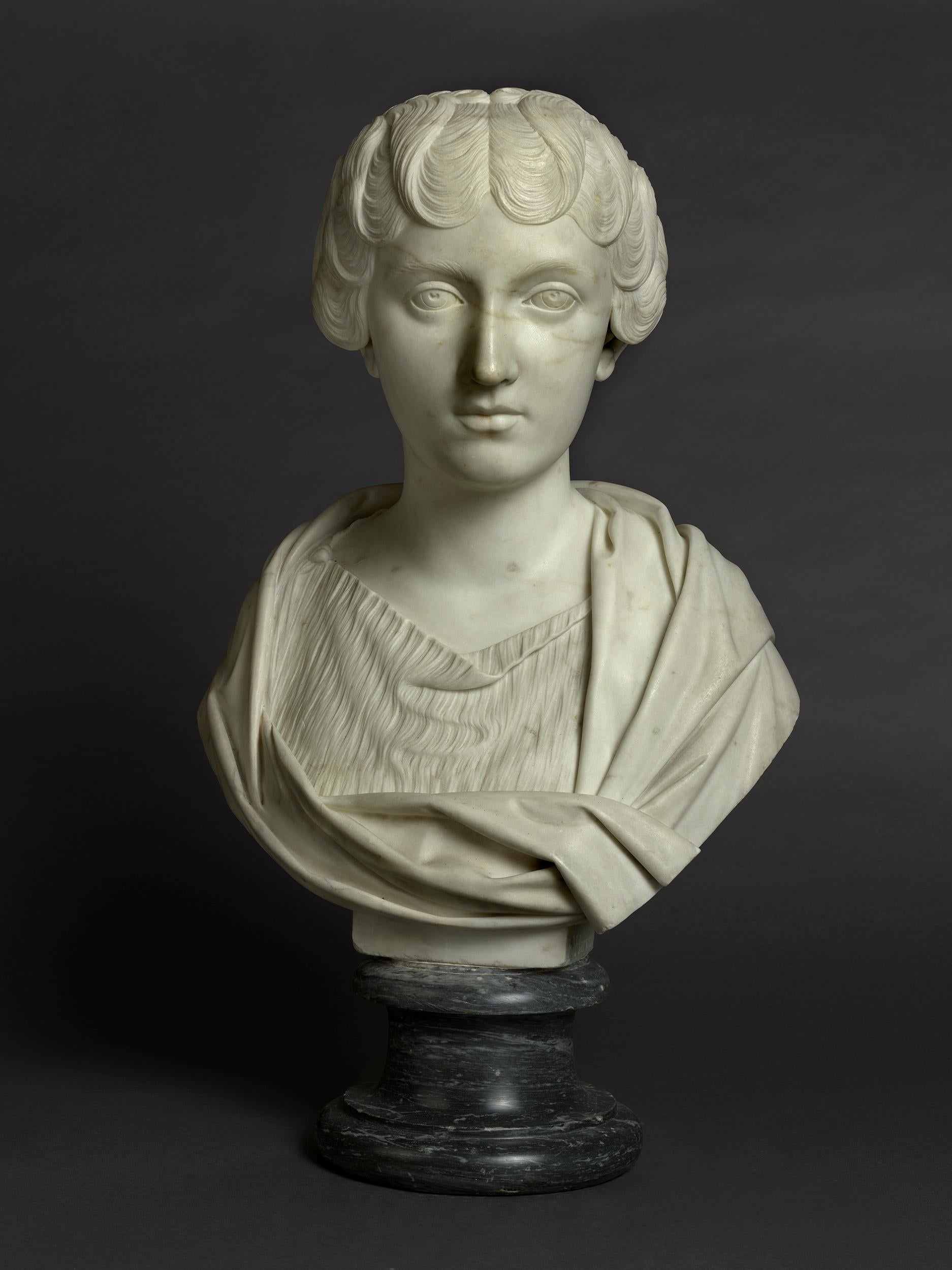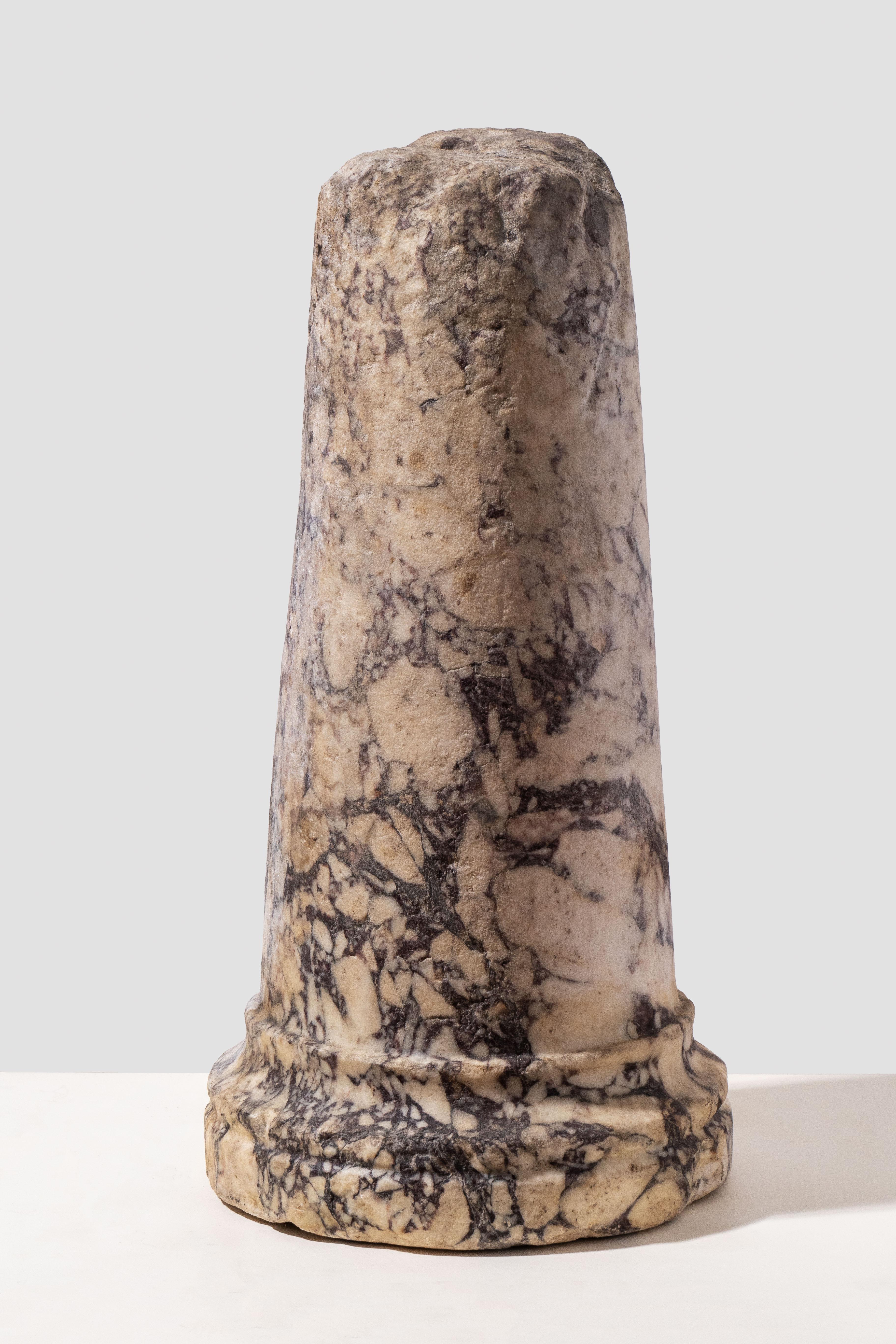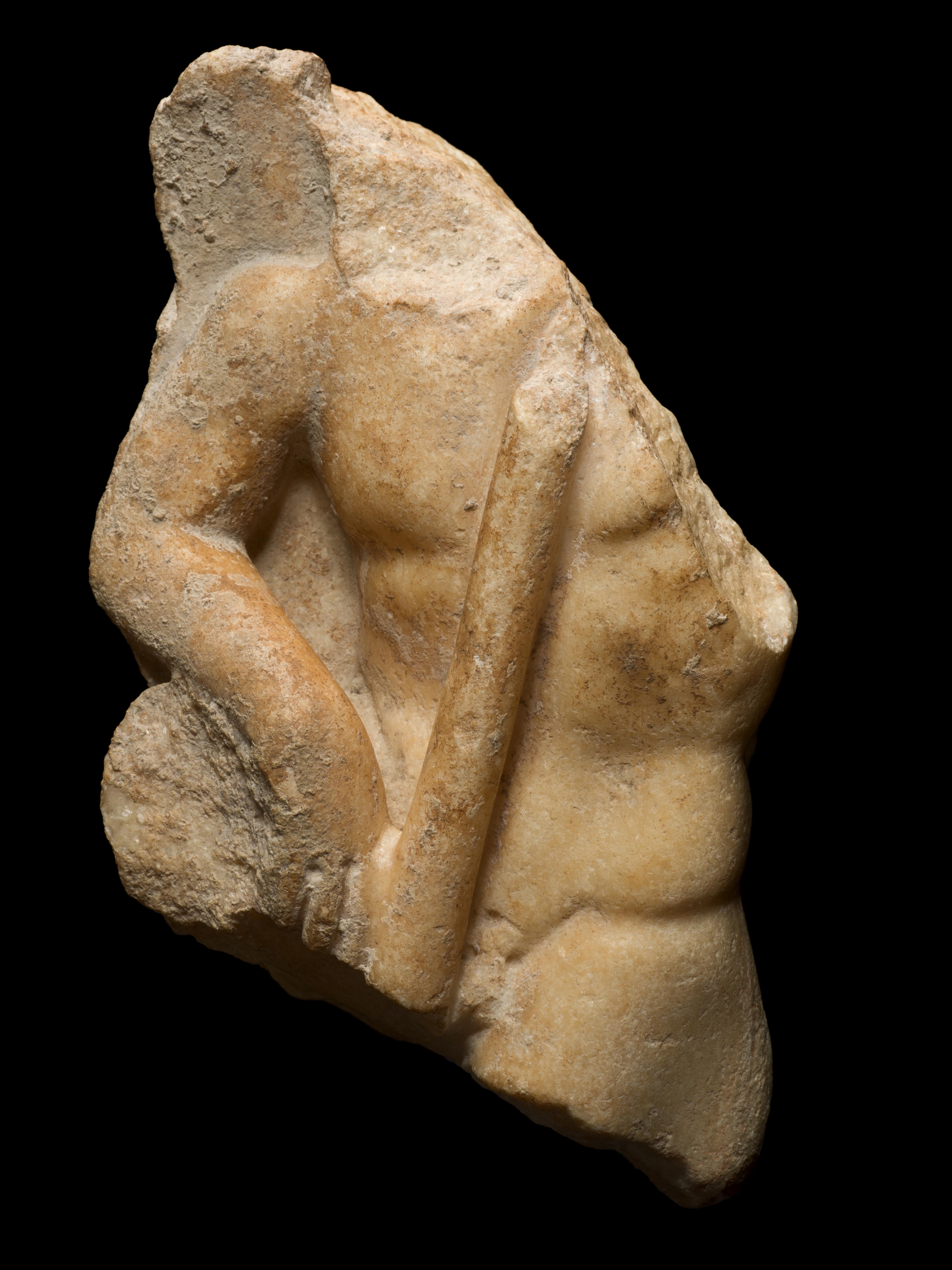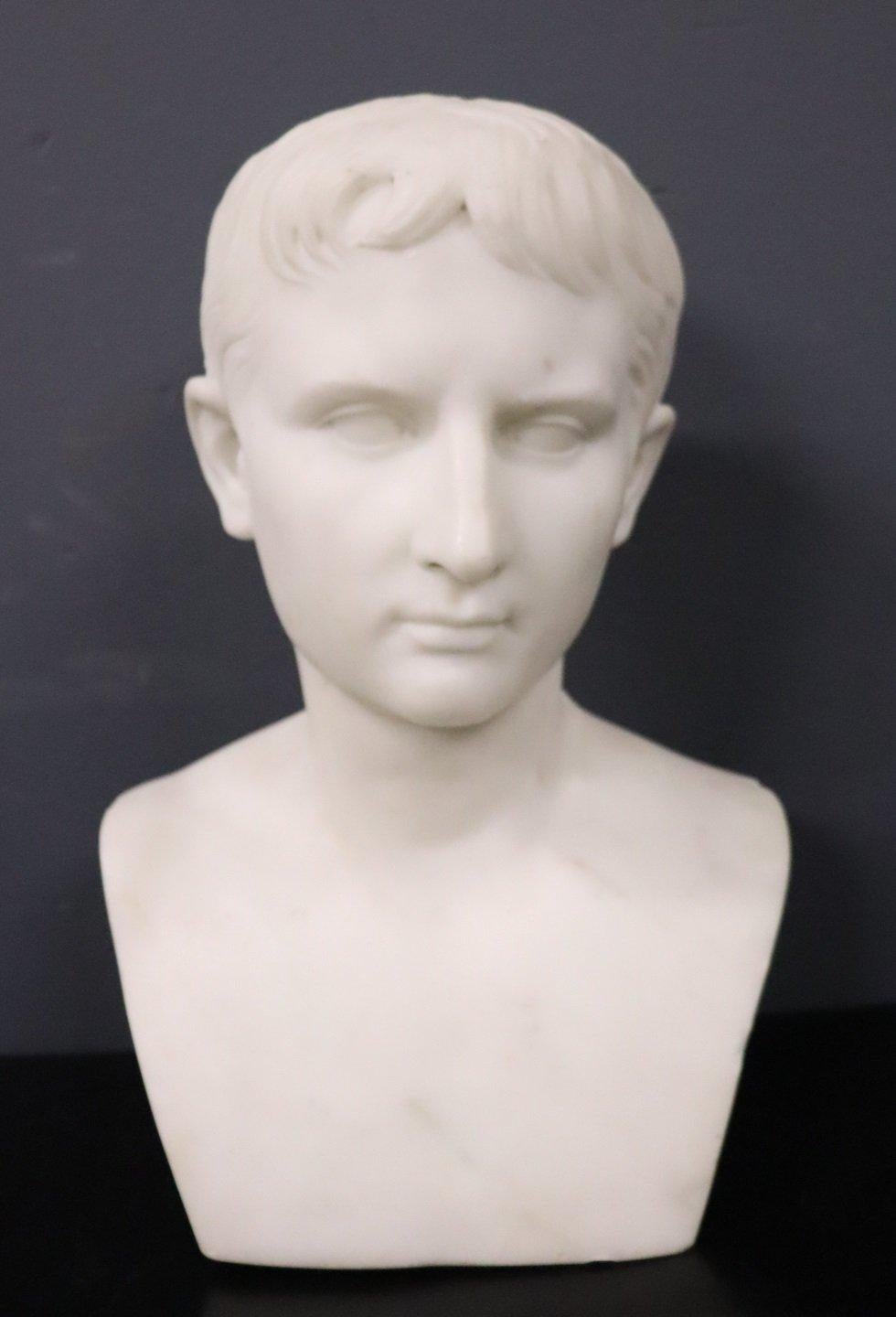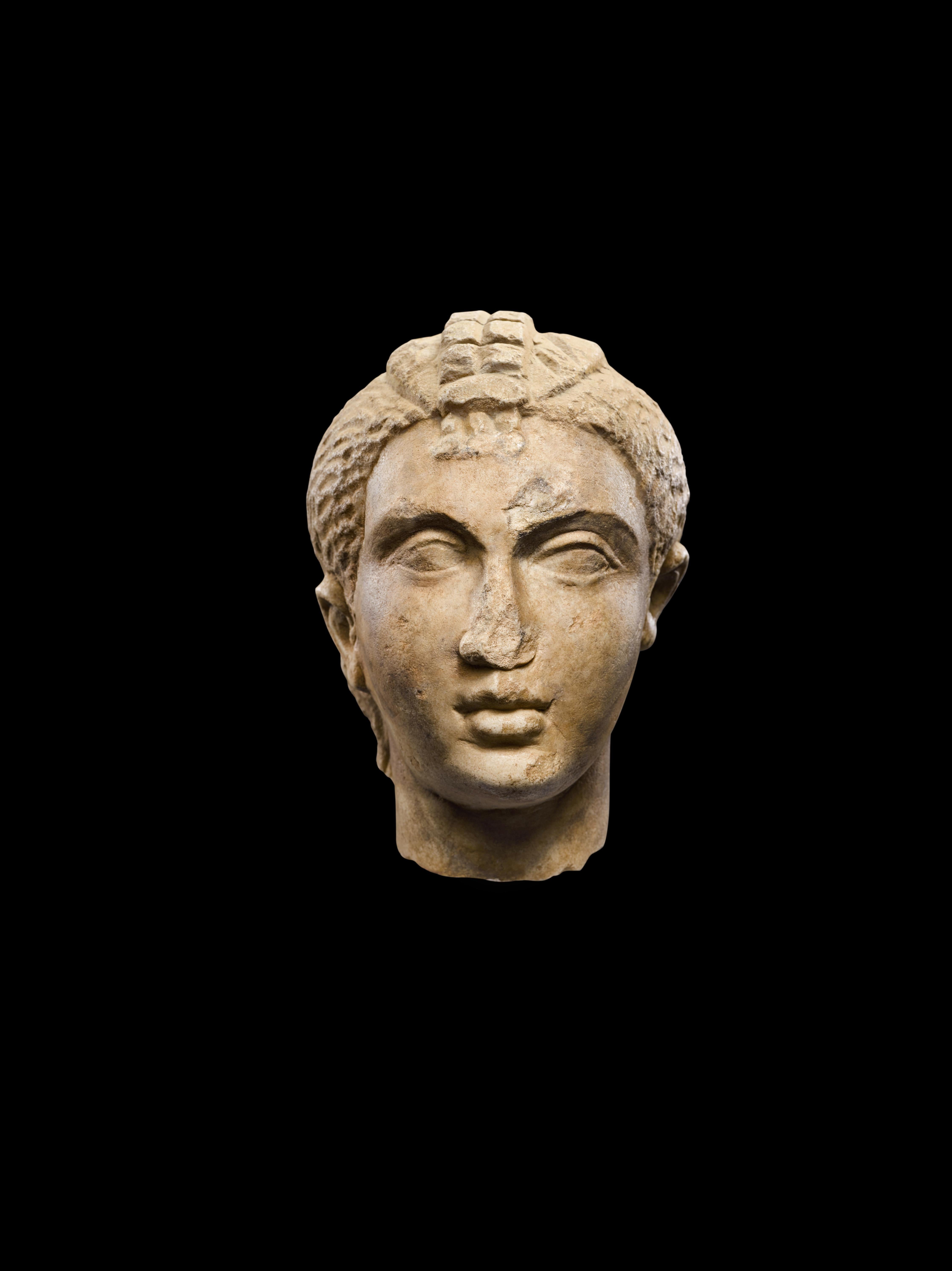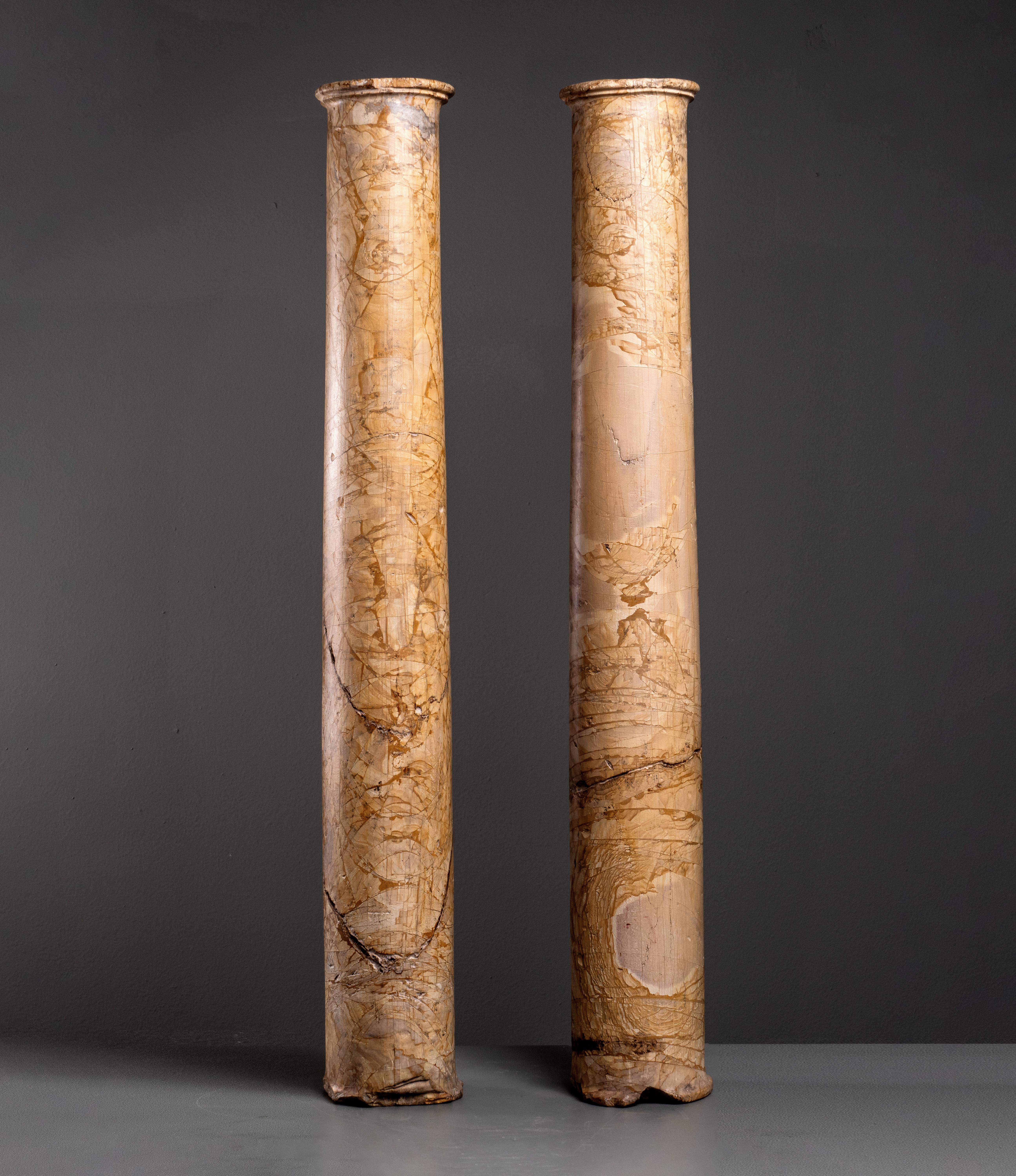Items Similar to Clio by Studio of Romanelli
Want more images or videos?
Request additional images or videos from the seller
1 of 8
UnknownClio by Studio of RomanelliEarly 20th century
Early 20th century
About the Item
Studio of Raffaello Romanelli
Early 20th Century Italian
Clio
Inscribed "Executé sous la Direction du Prof. Romanelli" (on base)
Marble
Clio, the muse of history from Greek mythology, is the subject of this compelling neoclassical marble sculpture that hails from the studio of Raffaello Romanelli. Romanelli was the son of the celebrated Pasquale Romanelli, a collaborator of Lorenzo Bartolini who assumed control of his studio following the master's death. He was renowned for his marble studies of the female form, and both his masterful eye and studio were inherited by his son Raffaello. Where Raffaello differed from his father was in his use of multi-colored marbles, a design choice that is displayed in the present work, which was executed by a student in his atelier.
The stark, pure white of this Clio is perfectly complemented by her robes carved from Siena marble, lending texture and visual interest to her overall form. Her tablet is inscribed "Historia non assentationi, sed fidei veritatique componitur. Pinius," a quote from the letters of Pliny the Younger that roughly translates to "History is written not for display but in the interests of strict truth." The quote was the perfect choice for the mythological figure, who was heralded as "the Proclaimer" of historical truths.
Early 20th century
22 1/4" wide x 15" deep x 52 1/8" high
Base: 23" wide x 23" deep x 27 1/4" high
- Creation Year:Early 20th century
- Dimensions:Height: 52.13 in (132.42 cm)Width: 22.25 in (56.52 cm)Depth: 15 in (38.1 cm)
- Medium:
- Period:
- Condition:
- Gallery Location:New Orleans, LA
- Reference Number:
About the Seller
5.0
Vetted Seller
These experienced sellers undergo a comprehensive evaluation by our team of in-house experts.
Established in 1912
1stDibs seller since 2013
13 sales on 1stDibs
Typical response time: 4 hours
- ShippingRetrieving quote...Ships From: New Orleans, LA
- Return PolicyThis item cannot be returned.
More From This SellerView All
- CoupleBy Agustín CárdenasLocated in New Orleans, LAInfused with a crisp modernity and subtle sensuality, this bronze sculpture by Cuban-born artist Agustin Cárdenas is an exceptional example of late-2...Category
20th Century Modern Figurative Sculptures
MaterialsMarble, Bronze
- MasqueradeBy Fortunato GalliLocated in New Orleans, LAMasquerade, a traditional yet playful composition by Fortunato Galli, reflects the realism and intricacy that defined Italian sculpture at the end of the 19th century. Magnificently ...Category
19th Century Other Art Style Figurative Sculptures
MaterialsMarble
- Bust of Pope Innocent XI Odescalchi by Domenico GuidiLocated in New Orleans, LAThis monumental bust is a museum-quality example of Roman Baroque sculpture. Crafted by the legendary Domenico Guidi and carved from Carrara marble, the impressive portrait captures the visage of Pope Innocent XI, Benedetto Odescalchi (1611-1689). It presents a larger-than-life example of Guidi’s remarkable skill as a sculptor, which ultimately made his workshop one of the most important in Rome during his age. Today, his works are rarely found on the market, particularly his extraordinary works in marble. Pope Innocent XI was born Benedetto Odescalchi into an Italian noble family of prominent bankers. Spending his early years in banking, he eventually turned to the law, earning his doctorate in 1639. His background would serve him well in his service to the papacy, and he became known as a frugal and devout member of the Church. In 1676, he was unanimously elected Pop after the death of Clement X. During his nearly 13-year reign, he instilled his own personal ideals of austerity and frugality onto the Church, with a deep commitment to reform and piety. He is captured here by Guidi in his traditional Pope’s mozzetta and camauro cap. A wide stole is draped over his shoulders, ornamented by acanthus leaves and the coat of arms of the Odescalchi family. It displays Guidi’s mastery over the chiaroscuro effect, particularly in the high level of contrast in his cheeks and his eyes, which Guidi achieved through various methods of high polish. A very similar portrait sculpture of Pope Innocent XI by Guidi can be found in the collection of the Royal Castle in Warsaw. The Warsaw bust belongs to a series of portraits of popes which the Odescalchi family commissioned from Domenico Guidi in the 1690s. Compared to that example, the present bust is far more dramatic, with deeper cut lines and a more precise expression. It is likely that the present piece was seen by the Odescalchi family, who ordered a similar one to be made. The piece was almost certainly intended to be displayed in a niche, given its dramatic cutting and its roughly carved back. Others of Guidi’s busts can be found in important collections throughout Italy, England and the United States, though many of these are lesser bronze repetitions. A bronze bust of the Pope Alexander VIII by Guidi is currently in the collection of the Victoria & Albert Museum (London), while a terracotta version of the same is in the Los Angeles County Museum. A bronze of Pope Alexander VIII can be found in the Princely Collection of Lichtenstein, and his impressive marble papal bust of Clement IX graces the pope’s tomb in Santa Maria Maggiore. The present bust of Pope...Category
17th Century Baroque Figurative Sculptures
MaterialsMarble
- Italian Marble Sculpture Of Venus And CupidLocated in New Orleans, LABeautifully detailed and lifelike, Venus and Cupid share a soft embrace in this remarkable Italian white marble sculpture. The feminine beauty gracefully leans against roughened rock...Category
19th Century Nude Sculptures
MaterialsMarble
- THE LAST DAYS OF NAPOLÉON BYLocated in New Orleans, LAThis highly evocative bronze by Vincenzo Vela captures the deposed Emperor Napoléon on his deathbed, holding a map of Europe and lost in thought about what might have been. Remarkable among most portrayals of the exiled leader, this highly detailed sculpture depicts Napoléon at his most vulnerable. Nonetheless, Vela perfectly captures his still-heroic bearing, which imparts to this work a monumental quality and quiet dignity. The mate to this figure is the colossal marble at the Musée du Château de Malmaison, which was shown at the Paris Salon of 1867. The founder of the verismo movement in Italy, Vela was one of the great exponents of realism in sculpture. Born in Ligornetto, Switzerland in 1820, he studied under celebrated sculptor, Benedetto Cacciatori. He was also influenced both by the work of Tuscan sculptor Lorenzo Bartolini, who seamlessly combined neoclassicism with naturalism and the romantic painting of Francesco Hayez...Category
19th Century Realist Figurative Sculptures
MaterialsMarble, Bronze
- Limestone Buddha Head, 6th-Century Qi DynastyLocated in New Orleans, LAThis limestone bust of the Buddha presents a picture of serenity and grace. A rare and striking image, it was sculpted in 6th-century Northern China during the Qi dynasty...Category
15th Century and Earlier Figurative Sculptures
MaterialsLimestone
You May Also Like
- Eighteenth-century Grand Tour marble bust of Faustina the YoungerLocated in London, GBSigned and dated: ‘F. Harwood Fecit 1764’ Collections: Probably commissioned by Alexander Gordon, 4th Duke of Gordon (1743-1827); Probably by descent at Gordon Castle, Banffshire to c.1948; Possibly acquired by Bert Crowther of Syon Lodge, Middlesex; Jacques Hollander (1940-2004); Christie’s, 5 December 2013, lot 101; Private collection; Sotheby’s, 2 July 2019, lot 106 Literature: John Preston Neale, Views of the seats of noblemen and gentlemen, in England, Wales and Scotland, London, 1822, vol.I, unpaginated. This marble copy of an ancient bust in the Musei Capitolini usually identified as Faustina the Younger, the daughter of Antoninus Pius and future wife of Marcus Aurelius, was made in Florence by Francis Harwood in 1764. Harwood was one of the most prolific suppliers of decorative marbles for the Grand Tour market and this finely worked example demonstrates the quality of luxury goods available to travellers to Italy. So often anonymous, this unusually signed and dated example, raises questions about the status of marble copies in the period and of sculptors such as Harwood who are known principally for ornamental work. Harwood’s origins remain obscure. He is documented living in Palazzo Zuccari with Joshua Reynolds and the Irish sculptor Simon Vierpyl at Easter 1752, he had certainly settled permanently in Florence by the following year, when he is recorded working with Joseph Wilton. He was admitted to the Florentine Academy on 12 January 1755 (as pittore Inglese, although he was described as scultore in the matriculation account). After Wilson returned to England in 1755 Harwood appears to have worked in a studio near SS. Annunziata with Giovanni Battista Piamontini who had made life-size copies of The Wrestlers and The Listening Slave for Joseph Leeson in 1754. In 1758 both sculptors were contracted to make a statue and a trophy to complete the decoration of the Porta San Gallo, Harwood completing a statue of Equality, installed the following year. By 1760 Harwood was on the brink of his most productive period as a sculptor, producing copies of celebrated antiquities for the ever-increasing audience of Grand Tour travellers and for the domestic market in London. In 1761 Harwood met the young architect James Adam who was in Italy specifically to make contact with suppliers for Robert Adam’s burgeoning practice back in Britain. The Adams offered a remarkably cohesive design package to their clients, encompassing not just architecture, but fixtures, fittings and furniture as well. Harwood was able to supply the brothers with marbles for their new interiors. At Syon, for example, Harwood produced a full-size copy of Michelangelo’s Bacchus for the new dining room the Adams had designed for Hugh Smythson, 1st Duke of Northumberland. Harwood seems to have also specialised in producing sets of library busts. In 1758 Charles Compton, 7th Earl of Northampton, a distinguished traveller commissioned a set of busts which remain in situ at Castle Ashby in Northamptonshire. It is perhaps no coincidence that the Adam brothers were producing designs for new interiors at Castle Ashby at this date. The set included representations of: Cicero, Julius Caesar, Marcus Aurelius, Faustina the Younger, Sappho, Seneca and Homer. Each of these busts Harwood seems to have replicated for multiple patrons, another Adam patron, Thomas Dundas...Category
18th Century Old Masters Figurative Sculptures
MaterialsMarble
- ANTIQUE ITALIAN ARCHITECTURAL FRAGMENT OF PLINTH IN 'BRECCIA MEDICEA' MARBLELocated in Milan, ITBRECCIA FRAGMENT PLINTH Italy, 18th Century Breccia medicea 55 x d 25 cm 21 3/4 x d 9 3/4 inCategory
18th Century More Art
MaterialsMarble
- ANCIENT ROMAN MARBLE RELIEF OF A MALE TORSO, ROME, 2ND/3RD CENTURY ADLocated in Milan, ITThis muscular male torso probably comes from a larger relief, which would have decorated the front part of a sarcophagus. It likely represents the figure of a satyr, standing, with t...Category
15th Century and Earlier Nude Sculptures
MaterialsMarble
- ANTIQUE ITALIAN NEOCLASSICAL MARBLE BUST OF EMPEROR OCTAVIAN, SIGNED CLERICILocated in Milan, ITItalian 19th Century marble bust depicting the young Emperor Octavian. The sculpture, carved in white Carrara marble, is an exquisite example of neoclassical works and shows a fascin...Category
Late 19th Century Figurative Sculptures
MaterialsMarble
- ANCIENT ROMAN MARBLE SCULPTURE PORTRAIT HEAD OF A GIRLLocated in Milan, ITPORTRAIT HEAD OF A GIRL Rome, circa 2nd/3rd century A.D. Marble height 18.4 cm height 7 1/4 in Provenance: Sotheby's, London, May 23rd, 1988, no. 240,...Category
15th Century and Earlier Figurative Sculptures
MaterialsMarble
- RARE PAIR OF ITALIAN PIETRA PAESINA COLUMNS, Italy, 19th CenturyLocated in Milan, ITRARE PAIR OF ITALIAN PIETRA PAESINA COLUMNS, Italy, 19th Century Pietra Paesina H 70 x Diam 9.5 cm H 27 1/2 x Diam 3 3/4 inCategory
19th Century Figurative Sculptures
MaterialsMarble
Recently Viewed
View AllMore Ways To Browse
Antique Quotes
Neoclassical Marble Sculpture
Antique Marbles
Sculpture Greek Mythology
Historical Letters
Greek Female Sculpture
Greek Muses
Italian Carved Marble Neoclassical Sculpture
Greek Robe
Greek Muse Sculpture
Romanelli Marble Sculpture
Two Men Sculpture France
Balloon Wall Art
Resin Cat
Bee Sculpture
Funny Sculpture
Wood Beatrice
Epoxy Installation
